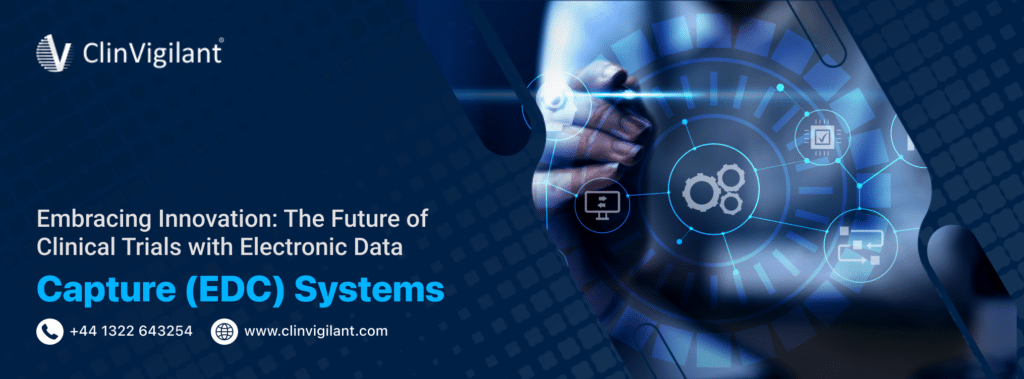
Clinical trials are an essential part of developing new drugs and therapies. However, historically they have relied on paper-based data collection, which can be tedious, inefficient, and prone to errors. Electronic Data Capture (EDC) systems are revolutionizing clinical trials by enabling faster, more accurate data capture through digital means. As EDC systems continue advancing, they promise to reshape clinical trials and accelerate the drug development pipeline.
What is an Electronic Data Capture (EDC) System?
An Electronic Data Capture in clinical trials system is software that allows clinical trial data to be collected digitally instead of on paper. EDC systems provide electronic case report forms (eCRFs) and interfaces for sites to submit subject data for analysis. This data is securely transmitted, processed, and stored on servers.
EDC clinical trials systems consolidate data entry and provide quality checks to improve accuracy. They enable remote data capture, real-time query management, and faster database locks. All data flows electronically without relying on fax, paper, or manual processes. EDC delivers immense time and cost savings versus paper.
Importance of EDC Systems in Clinical Trials
EDC systems provide major benefits throughout clinical trials:
- Accelerated Start-Up: EDC allows sponsors to design studies, build eCRFs, train sites, and initiate trials 66% faster than paper.
- Reduced Data Queries: Real-time data checks and automated logic reduce queries by up to 50%, alleviating sites.
- Faster Database Locks: Without paper handling, data can be processed 2-4 weeks faster, enabling quicker analysis.
- Improved Data Quality: Online edits, cross-checks, and integrated coding reduce errors and enhance data integrity.
- Effective Risk-Based Monitoring: Analytics highlight issues for targeted intervention versus 100% source data verification.
- Streamlined System Access: All users access the same system with proper permissions rather than shuffle papers.
- Enhanced Compliance & Transparency: Complete audit trails track data handling, changes, and system access.
As clinical trials become more global and complex, EDC provides standardization, oversight, and speed that paper cannot match. EDC is now considered a best practice.
Challenges and Considerations
However, adopting EDC poses important considerations:
Training: Sites may be unfamiliar with EDC workflows, requiring extensive training and support. Phased adoption can ease transition.
Connectivity: Remote sites may lack reliable internet for web-based systems. Alternatives like local networks or offline modes provide backup.
BYOD Trends: Sites often prefer using their own devices. EDC apps and validated device policies enable flexibility.
Data Migrations: Existing trials may require migrating legacy data into their EDC system, adding costs.
Service Quality: Cloud-based EDC depends on consistent vendor uptime and performance for global access.
Cybersecurity: Strict protections are essential as EDCs contain protected health information. Controls like encryption, access limits, auditing must meet regulations.
Despite these challenges, the benefits outweigh the adoption hurdles for most sponsors. Careful vendor selection and internal change management streamline EDC integration.
Advanced AI Features of EDC Systems in Clinical Trials
EDC In clinical research systems are integrating artificial intelligence (AI) and machine learning (ML) to further enhance clinical trials:
- Natural Language Processing: Tools can extract meaning from unstructured textual data like clinician notes to auto-populate eCRFs.
- Voice/Facial Recognition: Emerging biometrics confirm user identities for secure access and e-signatures.
- Predictive Analytics: ML detects patterns predictive of issues like patient dropouts, helping sites intervene.
- Risk-Based Monitoring: By analyzing data variations, rule violations, and site metrics, AI highlights top issues for monitors to address. This allows targeted oversight.
- Intuitive Interfaces: Smart designs with conversational UIs, real-time chatbots, and augmented annotations simplify complex tasks for sites.
- Cybersentinel: AI cybersecurity detects external and insider threats by learning normal network patterns and identifying anomalies in user behavior or data access.
As AI/ML mature, EDCs will gain more self-optimizing abilities from data they accumulate. AI can make systems and trials operate smarter – not just faster.
Future Trends and Innovations for Clinical Trials
Multiple accelerating technology trends will shape the EDCs of tomorrow:
Decentralized Clinical Trials (DCTs) depend heavily on EDCs to enable patient participation from home while maintaining data security and quality.
Real World Data (RWD) from apps, wearables, sensors, and medical devices capture patient experiences outside controlled studies. Integrating this data with EDCs enriches evidence available for treatments.
Virtual studies erect complex trial simulations for rapid low-cost testing of assumptions to refine real-world trials. Highly configurable EDCs underpin simulations.
5G networks and exponential data creation will stress EDCs to securely manage huge datasets necessary for longitudinal studies using advanced analytics.
As-a-service models like EDC Platforms-as-Service (PaaS) leverage cloud elasticity to scale system capacity on demand while letting sponsors configure unique workflows.
Blockchain-based EDCs establish immutable distributed records across systems to trace complete data histories from collection through transformations to analysis.
Wearable biosensors capturing physiological metrics or image scans using smartphones/tablets will directly integrate with Best EDC software in clinical research over 5G. This shrinks data collection hardware costs.
EDC in clinical research systems will keep advancing clinical trials through coming innovations in connectivity, analytics, mobility, security, and more.
Conclusion
Clinical trials endure an extremely manual, disconnected status quo relying on paper data and restricted site access. Electronic Data Capture (EDC) systems present a profound opportunity to accelerate and enhance trials through real-time digital data flows. From faster start-ups to AI augmented insights, EDCs elevate data quality, site experience, and sponsor oversight throughout the study lifecycle. While adopting EDCs requires internal change management and vendor diligence to navigate new cyber risks, the efficiencies unlocked are too significant to overlook.
As emerging solutions expand decentralizing and harnessing real world data, while next-generation platforms scale to vast datasets, EDC systems will form the digital backbone underpinning the future of clinical trials. Sponsors who embrace this innovation early will gain dramatic time, cost, and quality advantages over their competition.
Frequently Asked Questions
What is an EDC system?
An Electronic Data Capture (EDC) system is a software solution for collecting clinical trial data digitally using electronic case report forms instead of paper forms. EDC systems consolidate data entry, provide edit checks for accuracy, enable remote data capture, and accelerate overall study timelines.
Why are EDC systems important for clinical trials?
EDC systems deliver major advantages versus paper including faster study start-up, reduced site data queries, accelerated database locks for analysis, improved data quality through checks and standards, more effective risk-based monitoring, and enhanced compliance.
What AI capabilities are emerging in EDC systems?
Intelligent EDC features leveraging AI or machine learning include natural language processing, predictive analytics, risk-based monitoring algorithms, intuitive interfaces like chatbots, cybersecurity threats detection, and more to simplify use and optimize study oversight.
What future EDC trends will affect clinical trials?
Upcoming EDC advancements to further innovate trials include integration with decentralized and virtual trials, real world data from patient devices, scalability for huge datasets and analytics, as-a-service deployment models, blockchain traceability, 5G and wearables connectivity among others.
How can sponsors accelerate EDC adoption?
Organizations can speed EDC adoption by phasing rollout with specific user groups, ensuring connectivity and devices for sites, migrating legacy data, vetting vendor security and uptime, and managing internal change through training and support.

